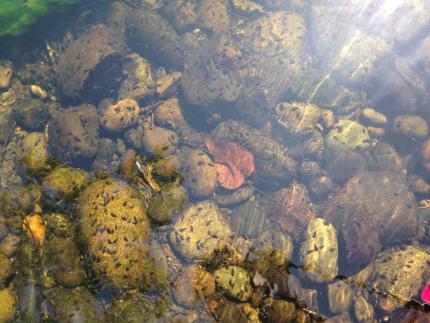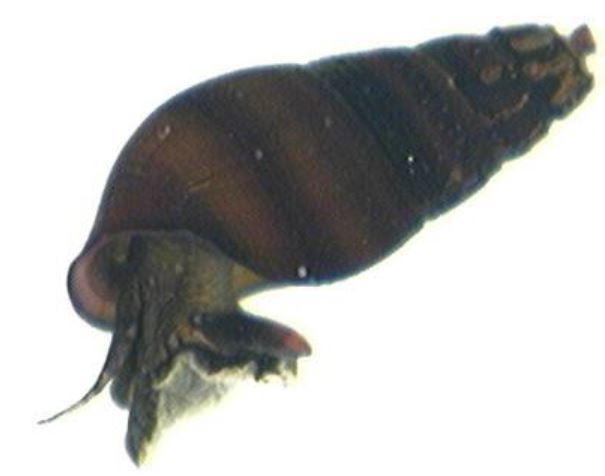Low-
Moderate
The Dalles juga is a freshwater aquatic gastropod. Their population size is considered low and the trend is unknown. Juga species generally require cold, clear, well-oxygenated water; they are sensitive to pollution, and intolerant of warm waters, low dissolved oxygen, or major seasonal fluctuations. Destruction of springs by grazing, logging, and water diversion, for such things as for water supply and fish hatcheries, has already caused extensive extinction of Juga species throughout western North America
Description and Range
Physical description
Juga species are medium-sized, aquatic, gilled snails with tall conical shells. This genus (Juga) is part of the family Semisulcospiridae. The Dalles juga is large (0.75 to 1 inch) and slender. It differs from other Juga by its uniform green color, or greenish or brownish yellow.
The taxonomy of the Semisulcospiridae, like most freshwater gastropods, has been based largely on shell morphology, and the tremendous variation makes the current taxonomy problematic and species identification difficult. Current work using reproductive anatomy and DNA to help resolve some of the taxonomic problems will likely result in changes in taxonomy in the future.
Ecology and life history
Juga species are native to the streams and springs of the Pacific Northwest, California, and the Great Basin. The Dalles juga is found in low elevation large springs and small to medium streams with a stable gravel substrate and fast-flowing, unpolluted, highly oxygenated cold water. Relatively few macrophytes or epiphytic algal taxa are present.

Juga snails are characterized as rasper-grazers, feeding on both algae and detritus on rock surfaces and deciduous leaf litter.
The egg masses of Juga are most often found in loose (non-cemented) but stable cobble substrate, with free and fairly vigorous flow through at least the upper substrate layers. Most Juga species appear to breed and lay eggs once a year as adults. Egg masses are located under rocks in the spring, and eggs hatch in one month. Juga species may lay eggs in the same location each year. Juga species live from five to seven years, reaching sexual maturity in three years, and can continue to grow.
Where found, Juga species can comprise over 90 percent of the invertebrate biomass in some streams.
Geographic range
The Dalles juga is found only in Oregon and Washington in the central and eastern Columbia Gorge, including The Dalles; the original distribution of this species is uncertain but likely the same. Some possible records of this subspecies have been identified in the Cowlitz Basin (Washington) and the Willamette Basin (Oregon). The distribution of this subspecies is not well understood. In Washington, isolated populations have been reported in Skamania County, in the Gifford Pinchot National Forest and Columbia Gorge National Scenic Area
Climate vulnerability
Sensitivity to climate change
Low-
Moderate
There is limited information on the sensitivity of the Dalles juga to climate change. There is very limited information on this species’ life history. The Dalles juga is found at low-elevation springs and streams in cool, clean, highly oxygenated water. This species may therefore be sensitive to changes in flow regimes and water temperatures that negatively impact dissolved oxygen levels and chemical and biological processes
Exposure to climate change
Moderate
- Altered flow regimes
- Reduced oxygen
- Increased water temperatures
Conservation
Conservation Threats and Actions Needed
- Fish and wildlife habitat loss or degradation
- Threat: Water diversion; habitat loss to development.
- Action Needed: Taxonomic clarification.
- Resource information collection needs
- Threat: Taxonomic uncertainty may mean one or more taxa are in greater decline.
- Action Needed: Taxonomic clarification.
This species' climate vulnerability is assessed as "moderate to high." Climate vulnerability (PDF) is a way to assess the degree to which a habitat or species is susceptible to and unable to cope with adverse impacts of climate change.
Resources
References
Blevins, E. and S. F. Jordan. 2015. Species fact sheet: Juga hemphilli dalliensis. U.S. Department of Agriculture, Forest Service, Interagency Special Status/Sensitive Species Program (ISSSSP).
Frest, T. J. and E. J. Johannes. 1995. Interior Columbia Basin mollusk species of special concern. Final report to the Interior Columbia Basin Ecosystem Management Project, Walla Walla, WA. Contract #43-0E00-4-9112. 274 pp. plus appendices.
USFWS. 2011. Endangered and Threatened Wildlife and Plants: 90-day finding on a petition to list 29 mollusk species as threatened or endangered with critical habitat: proposed rule. Federal Register 76 (No. 193, October 5, 2011): 61826-61853
